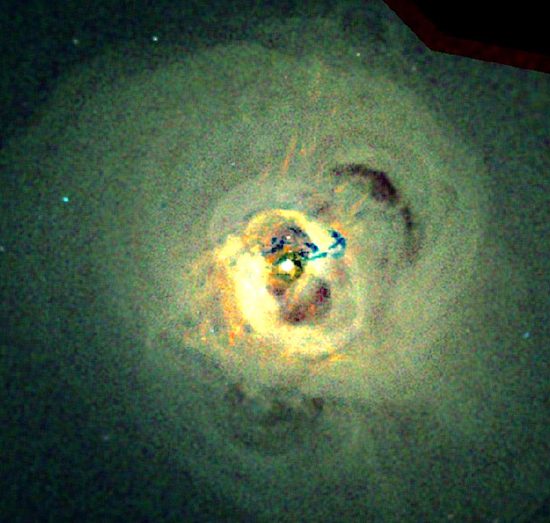
February 5, 2020
Galaxy cluster are like everything else in nature: electrical.
Many Picture of the Day articles discuss black holes, because they are often used to “explain” anomalous phenomena in space. As most Electric Universe advocates would insist, they exist only through some mathematical legerdemain, and have nothing to do with the substantive Universe.
Black holes are said to “twist and warp” space and time, so that velocity calculations yield impossible solutions. Theories suggest that inside of a black hole matter occupies no volume at all, yet retains gravitational acceleration so great that not even light can escape its attraction—thus they are “black” holes because they cannot be detected with optical telescopes. Although they are impossible to observe directly, over 90% of galaxies in the Universe are supposed to harbor those arithmetical monsters.
According to a recent press release, astronomers noticed anomalies in twelve “massive galaxies at the centers of galaxy clusters”. As their models state, “hot gas” is supposed to recirculate through any particular galaxy by cooling down and then “falling back” into the galaxy so new stars can form.
Despite observations that “…filamentary structures…characterize most of the gas in these central cluster galaxies,” there are no thoughts of field-aligned currents among the consensus.
In an Electric Universe, high-density currents flow out along galactic spin axes, forming double layers that can sometimes be seen as radio and X-ray lobes around active galaxies. Those currents then spread out around the circumference, returning to the core along the spiral arms. Every element in a galactic circuit radiates energy, indicating that they are powered through coupling with larger circuits. Galaxies appear to occur in strings, so the extent of the larger circuits can be inferred.
Plasma’s behavior is driven by conditions in those circuits. Fluctuations can form double layers with large potential voltages between them. The electric forces in double layers can be much stronger than those from gravity. Double layers separate plasma into cells and filaments that can have different temperatures or densities.
Double layers emit radio waves over a broad band of frequencies. They can sort galactic material into regions of like composition and condense it. They can accelerate charged particles to cosmic ray energies. Double layers can explode, releasing more energy than is locally present. This effect can be seen in stellar flares or so-called “nova” outbursts.
This vision of the cosmos sees various components coupled with and driven by circuits at ever larger scales. Electrons and other charged particles accelerating through intense electric fields radiate energy in many bandwidths. Changing conditions within the Birkeland current generators of some galaxies means that the radiation patterns change over time.
Retired Professor of Electrical Engineering Dr. Donald Scott, author of The Electric Sky, wrote about the way plasma acts in the Universe:
“In a laboratory plasma, of course, things happen much more quickly than on, say, galaxy scales, but the phenomena are identical—they obey the same laws of physics. In other words we can make accurate models of cosmic scale plasma behavior in the lab, and generate effects that mimic those observed in space…Electric currents flowing in plasmas produce most of the observed astronomical phenomena that remain inexplicable if we assume gravity and magnetism to be the only forces at work.”
Stephen Smith
The Thunderbolts Picture of the Day is generously supported by the Mainwaring Archive Foundation.












